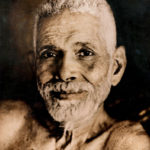 Went to a satsang last night at our local Unity Church. (“Satsang at Unity”: A promising combo, yes?) Alas, I guess I have too much cowboy in me, or cranky old geezer or new millennium artist to go along with the program. I was disappointed.
Went to a satsang last night at our local Unity Church. (“Satsang at Unity”: A promising combo, yes?) Alas, I guess I have too much cowboy in me, or cranky old geezer or new millennium artist to go along with the program. I was disappointed.
To begin with, if it had been a Christian Science lecture or the Rotary Club, or even a seventh grade Civics class, the satsang would have started promptly—no exactly—at seven p.m., as the flyer promised. From a Christian Science perspective, such precision would demonstrate awareness of and obedience to Divine Principle. The Rotary people would be prompt– would have started at 7– simply because promptness is a sign of good business: be open when the sign says you’re open. Starting promptly is also a way of honoring those people who actually showed up on time. (Seventh grade Civics class starts on time just because otherwise uncontrollable pandemonium breaks out.)
If this had been an ordinary people’s meeting and not advertised as satsang, then at seven, or thereabouts, someone—maybe even the featured speaker—would welcome those who were there and tell them the program would begin after a short meditation or period of silence. But last night’s Unity satsang followed the standard, somewhat silly, at least to me, modern day ritual of having a few of the followers, devotees, upfront arranging and rearranging the flowers, the water glass, the microphone, lighting the candles and making sure The Chair (the dais, the throne,) where the guru is to preside sits just right. And then after The Arranging, they return to their seats and we all sit in silent meditation, preferably with eyes closed, Awaiting.
So we waited, no one saying word one, candles burning, for at least ten more minutes. (I confess, I looked at my watch.) Our satsang lady did finally come out from behind the curtain, where she, too, had apparently been Awaiting, and, neither smiling nor unsmiling, took her seat in The Chair.
Oh good, I thought. The program should begin soon. Naturally, the guru lady was dressed in purple. Sitting down, she crossed her legs, again moved things around in her chair to suit her own sense of proper arrangements, and then, with a deep breath, she, too, without a word, closed her eyes.
So we meditated some more.
Satsang, for those of you unfamiliar, is nothing at all like the rodeo where when the buzzer goes off, the gate flies open and the bucking begins. No siree. Satsang is much, much slower. When the guru-ess closed her eyes, everyone else (almost everyone else) likewise closed theirs, as is the expected custom. This, apparently—though nobody said as much—was “transmission time.” She would transmit good vibes to the whole world, but more particularly to us, sitting there in the room, close to her, who had paid our dues.
I had a radical teacher once—Da Free John later known as Adi Da—who suggested that when you are in the presence of a realized being (which Da Freebie assured us he was), for Christ’s sake keep your eyes open! If you saw Jesus, would you close your eyes? Probably not!
The principle: Seeing a realized being with your physical eyes is a rare and evolutionarily beneficial sight, known in the east as darshan. Such visioning is an opportunity, so the story goes, of bringing together the inner and the outer, the yin and the yang, the subjective and objective, heaven and earth. No sense in closing your eyes and disappearing into yourself—your same old self. We do that every day, especially if we meditate. “Enjoy the site of your teacher,” I had learned.
But apparently that was not the teaching from this teacher.
(By the way, for what it’s worth Da Free John/Adi Da—ne’ Franklin Jones– later made claims and statements and such outlandish demands of his followers that it became apparent that he had, at some point, gone off the rails, at least somewhat, as western gurus are prone to do. Nevertheless, for many years he proved quite helpful for many of us as a lively introduction to what he aptly named The Great Tradition of Spiritual Awakening. He died in 2008 at the relatively young age of 69. May he rest in peace.)
Because of that early Da Freebie influence I was one of the few last night who mostly kept my eyes open, just to watch and be with and enjoy this new guru lady. I should here confess that I generally love new guru ladies, having known many of them in my time, and am deeply, deeply grateful for their work. In my view, we can’t have too many guru ladies. As Mao put it, “Let ten thousand flowers bloom.” The time and the planet are ready for more blooming, blossoming guru ladies.
So we meditated. And meditated. And meditated. Or at least we were quiet, with most of our eyes closed. I confess, I looked at my watch again. And then again. When it got to be 7:30, with no one having said anything yet—no one even making eye contact (the guru lady was not one of the ubiquitous “gazers”—at least not yet)—I started doing some calculations. Half an hour ago, at the start of the evening, seeing the basket, I had chipped in twenty bucks, the requested donation. The program was advertised to run from 7 to 9. So for this first thirty minutes I was already in for five bucks worth of satsang.
I got to thinking that our local cheap theater charges four bucks to see a fairly decent and recent movie on the big screen while enjoying the comfort of plush lean back chairs. Yes, of course, the popcorn costs twelve bucks (or thereabouts) but for four bucks you get an hour or two of million-dollar entertainment, diversion, shoot-em up car chase and/or fall in love all over again, in spite of the odds. Sorry to say, such a comparison went through my cowboy brain, there at 7:30, five bucks and counting into satsang.
Shortly thereafter, thank God, she finally came alive, at least a little. I knew she was alive because she started muttering. Really, just muttering. Still with her eyes closed. Like someone coming out of a coma.
I naturally assumed she was talking to us, but she was doing it in such a low, soft, muttering voice that I, an old geezer, couldn’t understand her. What the hell was she saying? I assumed—or at least hoped—that she would eventually open her eyes and actually speak up, talk to us, like a normal human being, but she just kept muttering. I was only third row back. I didn’t want to miss the second feature.
“What?” I accidentally said out loud. (Truly, it was an accident. Or least not intentionally public.) This prompted her to open her eyes—the first time since she sat down—and stare straight at me.
“What?” she asked back.
“I’m sorry,” I said softly, but in a normal voice. “I can’t hear what you’re saying.”
“Please move closer,” she immediately said. So I moved down to the first row. And then she turned to her sound man—sound woman. “Please turn up the microphone,” she said.
(There were only ten of us, total, in the room, so you can appreciate the low-level “holy whispering,” or muttering she was engaging if she needed both a microphone/sound system and for me to move from third row to first.)
“Can everybody else hear me?” she asked, in a fairly normal voice. In her normal voice I could hear her just fine. Only in her special “watch . . .the. . .space. . .between . . .your . . .thoughts” low-level muttering was it hard to hear. But everybody else had heard her just fine, or so they said.
When she was finally finished guiding us to The Presence btween our thoughts —which it apparently was assumed she had a special knack to contact and process and transmit and share with others—she then went into “gazing” mode. She knew all the tricks.
 I suspect it was Grandpa Ramana Maharshi that started this practice, which gurus and guru-esses have been practicing ever since. The idea, or hope, is that when the guru stares into your eyes he/she can see the Divine truth of your being, all the way down to your socks. Such powerful divine seeing has the potential to free you of many inner devilish entanglements. And indeed, guru literature from around the world offers many testimonies of deep release, enlightenment and even physical healing of long term ailments simply from the glance of the guru. It apparently happened quite often with Ramana Maharshi.
I suspect it was Grandpa Ramana Maharshi that started this practice, which gurus and guru-esses have been practicing ever since. The idea, or hope, is that when the guru stares into your eyes he/she can see the Divine truth of your being, all the way down to your socks. Such powerful divine seeing has the potential to free you of many inner devilish entanglements. And indeed, guru literature from around the world offers many testimonies of deep release, enlightenment and even physical healing of long term ailments simply from the glance of the guru. It apparently happened quite often with Ramana Maharshi.
So at guru school they apparently teach the guru to lock eyes and hold the gaze for an extended period. At devotee school you learn you are supposed to try to hold the gaze and let the transmission fill you, or even better dissolve you, so you and the guru—The Presence Giver—are one.
Stories about Ramana Maharshi indicate this “awakening” via the gaze of the guru happened all the time with him. People would recognize, and dissolve into their own infinite nature simply by his gaze. So be it. I don’t think it was something Ramana was trying to do. It was his natural, ordinary way of looking at the world, except when he was cutting up the vegetables.
All said, the Gaze is a much more direct and less risky path to experiencing infinite nature than, say, mescaline or mushrooms or a thirty day juice and water fast. Stories are told all over the world of the effectiveness of “The Gaze,” though it seems to have become somewhat “mandatory” rather than spontaneous in many contemporary satsang settings.
I’m convinced Jesus was able to heal the multitudes primarily because all he saw was God, Perfect Love, everywhere he looked. When someone looks at you with perfect, unconditional love, it undoubtedly can indeed be life-transforming. Mothers and newborns share this gaze when they look into each other’s eyes. Such a gaze is not nearly as prevalent by the time the newborns become teens.
Alas, last night’s guru gaze was more akin to the gaze I have seen from various of my stop smoking clients who have a trace or more of schizophrenia or autism: someone stares at you way longer than the socially accepted norm, and the stare does not necessarily feel benign. You don’t know what the hell they’re thinking, but it feels a little creepy.
With last night’s guru-ess I assumed, or at least hoped, she was thinking, transmitting something benign. But the “openness” she was trying to express with her gaze seemed to have the opposite effect on me. I found myself closing up. I had a sense of someone not being completely honest, or at least completely grounded in her relationships. Nevertheless, having been to devotee training, I managed to meet her gaze, kept extended eye contact, kept staring back at her, hoping I could feel the transmission. We stared at each other until she gazed at someone else. Alas, I didn’t feel much. I guess sometimes I’m just an old crank. Perhaps in a different place, a different time, things might have been different.
After going around the room with The Gaze, she finally opened up to questions. To my way of thinking, she hadn’t said much, in her muttering guided meditation, that I could follow, or be inspired with. From her flyer, I knew she did have good credentials. She had studied with some well-known teachers and now was out on her own holding satsangs all over the country and in Europe. She also offered “retreats” and “intensives.” It seems she has a following.
“I work best in responding to your questions,” she said, again, a fairly common ploy among those SItting in the Chair I once saw Francis Lucille address a group of over five hundred people by starting with this assertion. I’ve seen other teachers do the same, usually after a session of The Gaze. I appreciate its usefulness, but again it often leads to a sense of “A special he/she with the answers” and a “we/us with the questions.” For those who actually do have the answers, the vision, the Presence, such an interchange can of course be life transforming. But that’s an early stage on the pilgrimage. When we recognize that the answers are everywhere, and that everyone has access to them, what should the group structure look like?
Nobody seemed to have a question. Or were just so moved by her transmission of The Presence that they were now at a loss for words. So, after an appropriate amount of silence, and just because I’m that type of guy, I finally asked, “How well do you function at Wal-Mart?”
“What?” the guru lady asked. She didn’t understand my question. I can’t blame her. So I explained.
“I’m an old guy. And these days my spiritual life seems to be simplifying, becoming very ordinary. If we put too much emphasis on spirituality being other-worldly, we sometimes forget to practice when we’re at Wal-mart.”
(I once asked Rupert Spira, a very down-to-earth yet other-worldly non- duality teacher, how well he functioned in Wal-Mart. His response was that when he’s in Wal-Mart he is generally trying to find the aisle where they hide the lens wipes. I love that guy.)

Rupert Spira
The guru lady looked at me funny. And then the thought occurred to me, which I blurted out: “maybe you yourself never go to Wal-Mart?” I was being honest. It struck me that maybe she really didn’t ever go to Wal-Mart.
“What do you mean by other-worldly?” she asked, somewhat defensively. “I’m not other-worldly.”
“When we come together as a group and spend thirty minutes with our eyes closed and not talking, that seems like we’re off in another world,” I said. I didn’t mention her trance-like mutterings or “other-worldly” silent gazing.
After a few back and forth clarifying words between us, she confidently assured me she was indeed able to stay completely open, completely present while at Wal-Mart. And then she asked me if I had a “real” question.
“Sure. How can we love more?” I asked. Her flyer said something about this satsang being a “bridge to love,” or something like that. And we hadn’t talked about love yet. I was giving her an opening.
She began answering my question, but I lost the thread of her thinking pretty quick. As I remember she basically said we shouldn’t get caught up in our own limited identities, and should instead let the divine move through us, which was obviously good advice. I was nodding my head in agreement, letting her know I was not one of those who likes to argue with the guruess. But I didn’t feel swamped in love, either.
At the end of her answer, I thanked her, which again is what we learn to do in satsang. It’s a convenient social signal to let the guru know we’re satisfied with the answer and grateful for the help and ready to let the microphone pass on to someone else (in need of help) . She accepted my thanks, and the implied invitation to move on, even though I didn’t have a microphone.
Curiously, the next person did use a microphone, even though, again, there were only ten of us in the room. And that next person did start, in accordance with proper satsang role playing, by holding the microphone, staring at the guru, not saying anything for a long, long moment, breathing deep to show how special, moving, and deep this (yet to be) conversation will be. (Sorry—again my cranky cowboy geezer mindset is showing through.) Many more questioners followed suit, and the Guru answerer helped as best she could.
It was an interesting evening. I deeply appreciate the guru lady’s boldness in what she is doing, or trying to do. It seems here in the west we still don’t have the cultural or organizational infrastructure in place to meet and share our non-dual natures in a very ordinary, yet inspirational and evolutionarily useful fashion. This guru lady, along with many, many others, is carving a path through the wilderness. (Again, there were only ten of us there, giving evidence that she was indeed “a voice crying in the wilderness,” though a voice alternately muttering and irritated.)
At the end of the evening we were invited to put our names on the e-mail list, put more into the donation basket and sign up for the somewhat expensive weekend “intensive” retreat. It was clear that maybe six or seven or the ten were already devotees, helpers, companions or students of the satsang lady. So only three or four of us were new folks, the true “public.” So be it. Numbers don’t tell much of the deeper story.
Sorry to say, but quite understandably, after the meeting adjourned I wasn’t sought out for further conversation or offered a polite openning to talk with any of the other folks, even though there were so few of us there. In the meeting I had not adequately confined or conformed myself to the currently accepted “satsang protocol,” and thus was probably perceived as a newbie to this whole transmission from the guru biz or simply was an old geezer who didn’t get it—didn’t get what was happening here.
But I did get it. I do get it. We can come together to share good company (which is what satsang means in Sanskrit.) We can share what we have in common—this presence (Presence) that both precedes and transcends time and space, that is neither subjective nor objective but is sweet, tender, alive, obvious: our common ground, our secret love, that which is so hard to talk about but which nevertheless needs to be talked about, for our own sanity, and the evolution and elevation of the human race. I do get that.
But we’re still learning how best to do this—how best to come together for such a purpose. Let’s don’t solidify—stultify—the process here too early on, for we are still early. We need to somehow make it easier, more natural, more open—this satsang, this good company we share. We’re still in the very early stages. The $4.00 movie is still right down the block.
(I’d be interested in hearing your response to this little essay. Please contact me via the form below…)
[bestwebsoft_contact_form]
 air, even throw up, lay down on the linoleum, cry, pound our fists, kick our feet. That’s only natural. But then we need to shut it off, 10 minutes, max. We need to conserve what energy we have left —mental, emotional, physical. We’re surrounded by barbarians.
air, even throw up, lay down on the linoleum, cry, pound our fists, kick our feet. That’s only natural. But then we need to shut it off, 10 minutes, max. We need to conserve what energy we have left —mental, emotional, physical. We’re surrounded by barbarians.











Recent Comments